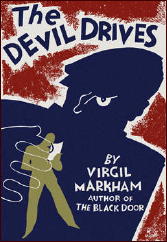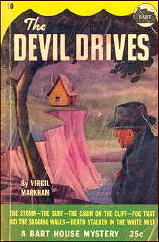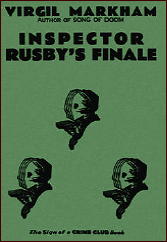Sun 15 Apr 2012
A 1001 MIDNIGHTS Review: VIRGIL MARKHAM – The Devil Drives.
Posted by Steve under 1001 Midnights , Reviews[7] Comments
by Charles Shibuk

VIRGIL MARKHAM – The Devil Drives. Alfred A. Knopf, hardcover, 1932. Bart House #10, paperback, 1944. Ramble House, trade paperback, 2007.
The Devil Drives is an offbeat and highly individual novel by a writer who, it would seem, must have had some familiarity with the work of that master American zany Harry Stephen Keeler. It is somewhat reminiscent of Keeler’s Amazing Web (1929), but is shorter, slighter, less ambitious, more straightforward, and, though complex enough in plot, lacks the unbelievable convolutions and ramifications of the Keeler work.
The authors do share the ability to propel their narratives forward in such a manner that readers will keep turning pages breathlessly in order to discover what astounding plot development will next occur, and what outrageous coincidence will help to resolve (or amplify) the current situation.

The Markham novel concerns George Lawson Peters, the warden of Franklin Penitentiary in New Jersey, who deserts his post to seek a lost treasure left by an adventurer nicknamed “Dubrosky” for a girl named Philadelphia Boston. On his odyssey, Peters meets a gangster with a heart of garbage; a repulsive blackmailer who exacts no tribute from his victims; the blackmailer’s unhappy wife; her friend the eccentric countess; and Detective Veen, who reads mysteries.
At the two-thirds point in the narrative, Peters encounters a honey of a locked-room problem. The door is locked and bolted, and the two windows are locked-all from the inside. The floor and ceiling are ungimmicked, and the fireplace and chimney show no signs of entrance or egress. The victim met his death by drowning. The author’s unique solution is even more bizarre than the problem he has propounded.

The locked-room situation and many strands of the plot are finally resolved by a few well-placed Keeleresque coincidences. But Markham has still done an ingenious job of deceptive clue-planting that is worthy of Christie, Carr, or Queen; and his unexpected and grimly ironic finale is worthy of Francis Iles or Richard Hull.
Markham’s other novels include Death in the Dusk (1928), The Black Door (1930), and Inspector Rusby’s Finale (1933). The last-named title has an irresistible premise:
A Scotland Yard inspector, spending a weekend at a crowded country house, wakes up the morning after his arrival to find that the hostess and guests have vanished and he is alone — except for the dead body of a perfect stranger. The ending, however, as Barzun and Taylor have noted, is a bit hard to swallow.
———
Reprinted with permission from 1001 Midnights, edited by Bill Pronzini & Marcia Muller and published by The Battered Silicon Dispatch Box, 2007. Copyright © 1986, 2007 by the Pronzini-Muller Family Trust.
Editorial Comments: Curt Evans recently posted on his blog a review of Red Warning (aka Song of Doom in the UK), another work of crime fiction by Virgil Markham. Included with the review is a considerable amount of information about the author himself, and I highly recommend it to you. (Follow the link.)
More. A link on Curt’s blog led to blogger TomCat’s review of Death in the Dusk, also by Markham, which he says “turned out to be a rival for Joel Townsley Rogers’ The Red Right Hand (1945) and Fredric Brown’s Night of the Jabberwock (1950) in the race for the title of most outlandish detective story ever contrived.”
April 15th, 2012 at 12:19 pm
I don’t know how I’ve missed reading anything by Virgil Markham until now, but I have. I’ve owned the paperback edition of DEVIL DRIVES for many years, but the rest of Markham’s output has flown completely below my radar.
From all sides, I have been shown the error of my ways.
April 15th, 2012 at 1:54 pm
Thanks for the link posting, Steve, also for Shibuk’s review. I was glad to see it was favorable! I think Markham is pretty interesting. A considerable plus is that he’s certainly original!
April 15th, 2012 at 4:19 pm
Wikipedia has an entry about Markham, but only in German .
The Doc
April 15th, 2012 at 4:24 pm
Well, I’m here for all the non-German fluency people. 😉
April 15th, 2012 at 8:46 pm
My review of THE DEVIL DRIVES has long been at my web site:
http://mikegrost.com/rogue.htm#Markham
It’s a strange, atypical mystery for its era.
April 15th, 2012 at 9:07 pm
Thanks for the link to your review of the book, Mike. You make it sound more like the book I had in mind and never got around to reading!
But I’m curious now about the locked-room part of the mystery. Let’s say that today I’m 4or 5 times more likely to read it than I was yesterday.
April 15th, 2012 at 9:39 pm
I’ll be reviewing something else by him within the fairly near future!